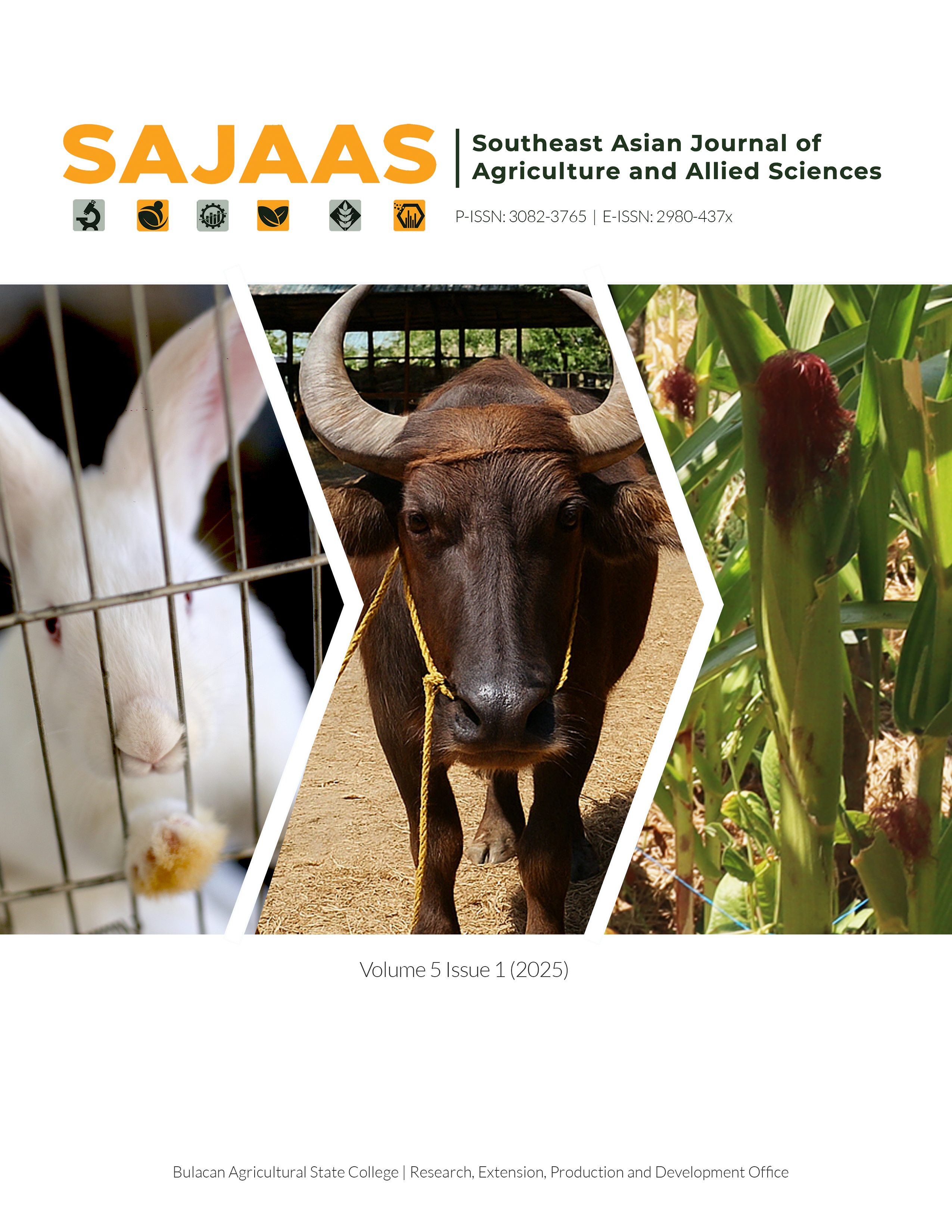Abstract
Sustainable farming systems have been acknowledged as an approach that balances the production of food and preservation of the environment. It involves practices that protect natural ecosystems such as soil conservation and water management, while also supporting the long-term economic viability for the farmers. To promote sustainable agriculture, various soil conservation technologies were introduced to corn farmers in Ilagan City, Isabela, Philippines through Sustainable Land Resource Management Approach (SLRMA). This study aimed to assess the intervention design and benefits of SLRMA to the 49 farmer-beneficiaries using the collected data on contour farming systems, crop diversification, training, and challenges encountered. A quantitative research design was utilized, incorporating descriptive and comparative approaches to examine and interpret the collected data. The analysis was focused on changes in production and profit before and after the implementation of SLRMA, using paired t-tests to compare these variables. Results revealed that SLRMA has had a positive and significant effect on farming practices and livelihoods, particularly for those with 2 to 5 years of participation. These beneficiaries experienced increased income, improved farming practices, and enhanced land productivity, including reduced soil erosion, restored cultivation areas, and higher crop yields. Beneficiaries with 5 years of involvement saw significant increases in ROI (from 16.54% to 147.81%), net income (from PhP5,504.45 to PhP45,724.45), and overall income (from PhP42,979.35 to PhP94,095.64). Similarly, 4-year, 3-year, and 2-year participants experienced notable improvements in ROI, net income, and overall income, with significant statistical results. On the other hand, only minimal changes with no significant impact on ROI and net income in the production were observed with 1-year participants. The study found that prolonged participation in the program was associated with higher income, but further analysis using more robust statistical methods is needed to determine the actual drivers of income changes. Based on the findings, recommendations include provision of additional support on manpower or financial assistance on the first year to ensure crop survival; evaluation of the suitability of the research design and methodologies employed for future researches; and formulation and implementation of strategic adaptation and upscaling plan for the SLRMA.
References
Adam, B., & Abdulai, A. (2024). Heterogeneous impact of crop diversification on farm net returns and risk exposure: Empirical evidence from Ghana. Canadian journal of agricultural economics/revue canadienne d’agroeconomie, 72(4), 469–487. https://doi.org/10.1111/cjag.12360
Bureau of Soils and Water Management. (2019). Sustainable Land Resource Management Approach (SLRMA). Department of Agriculture. https://www.bswm.da.gov.ph/program/slrma/
Choudhary, R., Sharma, S., & Gautam, S. K. (2024, October 21). Contour farming and strip cropping for soil protection. https://doi.org/10.61887/glp.2024.24
Do, V. H., La, N., Mulia, R., Bergkvist, G., Dahlin, A. S., Nguyen, V. T., Pham, H. T., & Öborn, I. (2020). Fruit tree-based agroforestry systems for smallholder farmers in Northwest Vietnam—A quantitative and qualitative assessment. Land, 9(11), 451. https://doi.org/10.3390/land9110451
Farahani, S., Fard, F. S., & Asoodar, M. A. (2016). Effects of contour farming on runoff and soil erosion reduction: A review study. ResearchGate. https://www.researchgate.net/publication/312054649
Gathagu, J. N., Mourad, K. A., & Sang, J. (2018). Effectiveness of contour farming and filter strips on ecosystem services. Water, 10(10), 1312. https://doi.org/10.3390/w10101312
Goldhamer, D. A., Beede, R. H., Sibbett, G. S., Kjelgren, R. K., Phene, R. C., & Ramos, D. E. (1995). Hedgerows use more water, but increase efficiency, profit in young walnuts. California Agriculture, 49(4), 24–28. https://doi.org/10.3733/ca.v049n04p24
Huss, C. P., Holmes, K. D., & Blubaugh, C. K. (2022). Benefits and risks of intercropping for crop resilience and pest management. Journal of economic entomology, 115(5). https://doi.org/10.1093/jee/toac045
Kansanga, M. M., Bezner Kerr, R., Lupafya, E., Dakishoni, L., & Luginaah, I. (2021). Does participatory farmer-to-farmer training improve the adoption of sustainable land management practices? https://doi.org/10.1016/j.landusepol.2021.105477
Nahar, N., M. Wakilur Rahman, Miah, M., & Md Mahfuzul Hasan. (2024). The impact of crop diversification on food security of farmers in Northern Bangladesh. Agriculture & Food Security, 13(1). https://doi.org/10.1186/s40066-023-00463-z
Omotilewa, O. J., Jayne, T. S., Muyanga, M., Aromolaran, A. B., Liverpool-Tasie, L. S. O., & Awokuse, T. (2021). A revisit of farm size and productivity: empirical evidence from a wide range of farm sizes in Nigeria. World Development, 146, 105592. https://doi.org/10.1016/j.worlddev.2021.105592
Philippine Statistics Authority. (2022). Updates on palay and corn estimates. https://psa.gov.ph/statistics/crops/palay-and-corn-estimates
Vernooy, R. (2022). Does crop diversification lead to climate-related resilience? Improving the theory through insights on practice. Agroecology and Sustainable Food Systems, 46(6), 877–901. https://doi.org/10.1080/21683565.2022.2076184
Wassif, O., & Meselhy, A. (2022). Effect of contour tillage system and water harvesting method on mitigation of soil and water erosion hazards. Natural Sciences Edition. https://doi.org/10.17605/OSF.IO/Y3KRF
Wonde, K. M., Tsehay, A. S., & Lemma, S. E. (2022). Training at farmers training centers and its impact on crop productivity and households’ income in Ethiopia: a propensity score matching analysis. Heliyon, 8(7), e09837. https://doi.org/10.1016/j.heliyon.2022.e09837
Wulandari, E., Karyani, T., Ernah, & Alamsyah, R. T. P. (2023). What makes farmers record farm financial transactions? empirical evidence from potato farmers in Indonesia. International Journal of Financial Studies, 11(1), 19. https://doi.org/10.3390/ijfs11010019

This work is licensed under a Creative Commons Attribution-NonCommercial-ShareAlike 4.0 International License.
Copyright (c) 2025 Southeast Asian Journal of Agriculture and Allied Sciences

